Opinion & Analysis
The data behind Keegan Bradley’s coaching change
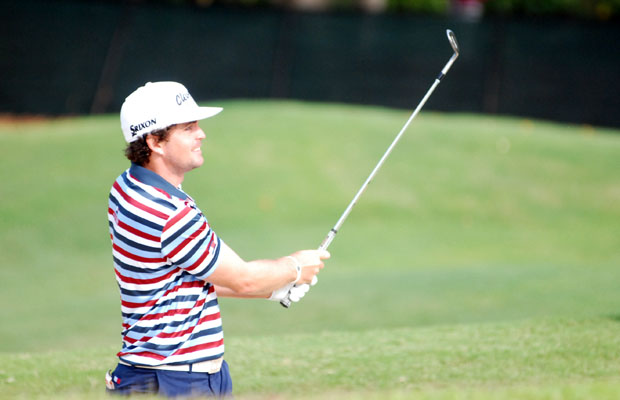
Keegan Bradley has reportedly left long-time swing coach Jim McLean for Chuck Cook, who teaches Bradley’s good friend Jason Dufner and Luke Donald. That gives Cook one of the most formidable list of clients in the golf world, as Bradley is ranked No. 20 in the Official World Golf Rankings, Dufner is ranked No. 15 and Donald is ranked No. 17.
I wanted to take a look at the numbers behind Bradley’s game and to see why he may have decided to change instructors. According to Bradley, the change was prompted by his familiarily with the instructor.
“I’ve been around Chuck Cook for a few years now, playing practice rounds with Dufner,” Bradley told Back9Network’s Ahmad Rashad. “I’m excited to get working with Chuck and get another opinion of how he thinks I can improve my golf game. He’s been around for a long time and I know he has several ways he can help me win.”
Bradley did not record a victory last season, but still finished No. 11 on the money list. When I look at a golfer’s game, I like to first analyze his or her scoring data. This helps me formulate some sort of idea of as to what went on with the golfer and provide a profile of the player’s game as far as his or her strengths and weaknesses go.
Bradley ranked No. 10 in Total Adjusted Scoring Average. Taking that into account and his rankings in the metrics in the table above, he still had a great season despite not coming away with a victory. I feel with these metrics that Bradley should be striving toward being the No. 1-ranked golfer in the world. He does not have a glaring weakness, and is instead trying to take his great game to the next level.
If Bradley is going to contend for the No. 1 spot, he will need to get inside the top 10 in Adjusted Par-4 Scoring Average. Par-4 play has the strongest correlation to Tour success of the metrics listed above. This is partially due to the number of par-4’s played per round (the Tour average is roughly 11 played per round), and the par-4’s require a more complete game to play them well. Bradley did a fine job in 2013 on the par-4’s. However, in order to contend for the No. 1 ranking in the world that will have to step up.
The biggest “weakness” we see with Bradley’s game is his play on the par-3’s. While par-3 play is important, it has the lowest correlation to success on Tour of the metrics listed. With that said, par-3 play is one part iron play, one part short game and one part long putting (putts longer than 15 feet). While Bradley was still an above-average player on the par-3’s, given that it was his weakest metric, I can start to develop an idea of what some of his issues in 2013 were.
Lastly, he had a fantastic year at avoiding bogies. Avoiding bogies has a stronger correlation to success on Tour than making birdies. He also made a high percentage of birdies. But, for him to contend for the No. 1 ranking in the world, he needs to get into the top 10 in both Birdie and Bogey rates. Furthermore, I find it a bit peculiar that the No. 1-ranked player on par-5’s ranked 24th in Birdie Rate. In all, I can start to envision a profile for Bradley’s game.
DRIVING DATA
I utilize an algorithm based on historical driving data on Tour dating back to 2007 to determine a golfer’s effectiveness off the tee. This is called Driving Effectiveness which utilizes the following metrics:
- Distance
- Fairway Percentage
- Average Distance to Edge of Fairway (on drives that miss the fairway)
- Fairway Bunker Percent
- Missed Fairway – Other Percent (shots that end up in a hazard, O.B. rescue shots, etc)
Here is Bradley’s data for 2013
As we can see, driving was rarely a problem for Bradley in 2013, as he was the second most effective driver of the ball (only Henrik Stenson was more effective). Bradley hits the ball a long way and hits a lot of fairways. And when he missed the fairway, he did not miss by much and did a fine job at avoiding fairway bunkers and other trouble. He has been one of the premier drivers on Tour since he earned his card.
PUTTING AND SHORT GAME DATA
Often times, putting and short game play can be over-valued by golfers. However, nothing can prevent a golfer from winning a tournament like poor putting. In fact, nearly 70 percent of the winners on Tour this year finished in the top 10 in Putts Gained (also called Strokes Gained-Putting) for that tournament.
Bradley putted very well in 2013 from most distances. As I have mentioned in the past, the putts from 3-to-15 feet are the most important putts to make when it comes to affecting a player’s performance versus the field. Outside of 15 feet, the make percentage for Tour players becomes very volatile. What I mean is that golfers on Tour, regardless of overall putting skill, tend to be very inconsistent when it comes to make percentage outside of 15 feet. One year they can make a lot of putts from outside 15 feet, and the next year they struggle to make those same putts.
This would explain some of the issues that Bradley had on the par-3’s. Tour players are not likely to have a lot of close birdie putts on the par-3’s, and that is why par-3 performance is dependent on the golfer’s ability to make putts outside of 15 feet. However, Bradley’s make percentage on putts outside of 15 feet is likely to progress toward the mean. Therefore, his performance on the par-3’s is likely to progress in 2014.
Sometimes the problem with good overall putters on Tour is that they were inconsistent with their putting. When they were off, they were well off. And when they were on, they were making a lot of putts. And if they putt poorly in too many tournaments, they reduce their odds of winning those events. Here’s a chart looking at Bradley’s putts gained by event.
Out of the 20 events that recorded putts gained, Bradley was only losing strokes to the field on six of those events.
Here is a look at Bradley’s short game play:
Bradley was an average short game player in 2013. But he did perform well from the most important part of the short game, longer pitch shots from 10-to-20 yards. This could also explain why he was better at avoiding bogies than making birdies. The 10-to-20 yard shots are usually more reserved for when the player needs to save par. The 1-to-10 yard shots are more makeable chip shots.
After looking at the data I see no reason why Bradley cannot contend for the No.1 spot in the world ranking based off his driving, putting and short game data. This only leaves approach shots.
APPROACH SHOT DATA
Here is Bradley’s approach shot data for 2013:
The good news is that the area that correlates strongest to success on Tour, the Danger Zone, is where Bradley was his strongest. Shorter shots, particular wedge play, are vastly overrated by the golfing community. This is why Bradley still had a fantastic year. His long game, both driving and Danger Zone play, was superb. This is where a golfer can gain the most strokes against the field over time.
Here’s a look at Bradley’s rankings from the various zones since he made the Tour:
We can see that Bradley has had issues with his iron play since he has made the Tour. His play from the Danger Zone has improved dramatically, and that has helped propel him into superstar status. But the play from the Birdie and Safe zones is what is holding him back. We also have to remember that his Safe Zone play is even worse than the ranking indicates because he was such an exceptional driver of the ball, which means he should have been in great position to hit a lot of Safe Zone shots closer to the hole.
His struggles from 75 to 175 yards would be part of the reason why he lagged a little behind on the par-3’s. It would also explain why his Birdie Rate was not better, as most birdies on the par-4’s come from Safe Zone and Birdie Zone approach shots.
All of these “issues” are nice issues for a player to have. I would expect that most of Bradley’s work with Cook will focus on improving his iron play from inside 175 yards. The key for him to take his game to the next level will be keeping his effectiveness off the tee and his skill on and around the greens while improving his iron play.
- LIKE1
- LEGIT0
- WOW0
- LOL0
- IDHT0
- FLOP0
- OB0
- SHANK0
Opinion & Analysis
The Wedge Guy: What really makes a wedge work? Part 1

Of all the clubs in our bags, wedges are almost always the simplest in construction and, therefore, the easiest to analyze what might make one work differently from another if you know what to look for.
Wedges are a lot less mysterious than drivers, of course, as the major brands are working with a lot of “pixie dust” inside these modern marvels. That’s carrying over more to irons now, with so many new models featuring internal multi-material technologies, and almost all of them having a “badge” or insert in the back to allow more complex graphics while hiding the actual distribution of mass.
But when it comes to wedges, most on the market today are still single pieces of molded steel, either cast or forged into that shape. So, if you look closely at where the mass is distributed, it’s pretty clear how that wedge is going to perform.
To start, because of their wider soles, the majority of the mass of almost any wedge is along the bottom third of the clubhead. So, the best wedge shots are always those hit between the 2nd and 5th grooves so that more mass is directly behind that impact. Elite tour professionals practice incessantly to learn to do that consistently, wearing out a spot about the size of a penny right there. If impact moves higher than that, the face is dramatically thinner, so smash factor is compromised significantly, which reduces the overall distance the ball will fly.
Every one of us, tour players included, knows that maddening shot that we feel a bit high on the face and it doesn’t go anywhere, it’s not your fault.
If your wedges show a wear pattern the size of a silver dollar, and centered above the 3rd or 4th groove, you are not getting anywhere near the same performance from shot to shot. Robot testing proves impact even two to three grooves higher in the face can cause distance loss of up to 35 to 55 feet with modern ‘tour design’ wedges.
In addition, as impact moves above the center of mass, the golf club principle of gear effect causes the ball to fly higher with less spin. Think of modern drivers for a minute. The “holy grail” of driving is high launch and low spin, and the driver engineers are pulling out all stops to get the mass as low in the clubhead as possible to optimize this combination.
Where is all the mass in your wedges? Low. So, disregarding the higher lofts, wedges “want” to launch the ball high with low spin – exactly the opposite of what good wedge play requires penetrating ball flight with high spin.
While almost all major brand wedges have begun putting a tiny bit more thickness in the top portion of the clubhead, conventional and modern ‘tour design’ wedges perform pretty much like they always have. Elite players learn to hit those crisp, spinny penetrating wedge shots by spending lots of practice time learning to consistently make contact low in the face.
So, what about grooves and face texture?
Grooves on any club can only do so much, and no one has any material advantage here. The USGA tightly defines what we manufacturers can do with grooves and face texture, and modern manufacturing techniques allow all of us to push those limits ever closer. And we all do. End of story.
Then there’s the topic of bounce and grinds, the most complex and confusing part of the wedge formula. Many top brands offer a complex array of sole configurations, all of them admittedly specialized to a particular kind of lie or turf conditions, and/or a particular divot pattern.
But if you don’t play the same turf all the time, and make the same size divot on every swing, how would you ever figure this out?
The only way is to take any wedge you are considering and play it a few rounds, hitting all the shots you face and observing the results. There’s simply no other way.
So, hopefully this will inspire a lively conversation in our comments section, and I’ll chime in to answer any questions you might have.
And next week, I’ll dive into the rest of the wedge formula. Yes, shafts, grips and specifications are essential, too.
- LIKE22
- LEGIT7
- WOW1
- LOL1
- IDHT2
- FLOP2
- OB1
- SHANK2
Golf's Perfect Imperfections
Golf’s Perfect Imperfections: Amazing Session with Performance Coach Savannah Meyer-Clement

In this week’s episode, we spent some time with performance coach Savannah Meyer-Clement who provides many useful insights that you’ll be able to implement on the golf course.
- LIKE0
- LEGIT0
- WOW0
- LOL0
- IDHT0
- FLOP0
- OB0
- SHANK0
19th Hole
Vincenzi’s 2024 RBC Heritage betting preview: Patrick Cantlay ready to get back inside winner’s circle

Just a two-hour drive from Augusta National, the PGA TOUR heads to Harbour Town Golf Links in Hilton Head Island, S.C. Hilton Head Island is a golfer’s paradise and Harbour Town is one of the most beautiful and scenic courses on the PGA TOUR.
Harbour Town Golf Links is a par-71 that measures 7,121 yards and features Bermuda grass greens. A Pete Dye design, the course is heavily tree lined and features small greens and many dog legs, protecting it from “bomb-and-gauge” type golfers.
The field is loaded this week with 69 golfers with no cut. Last year was quite possibly the best field in RBC Heritage history and the event this week is yet another designated event, meaning there is a $20 million prize pool.
Most of the big names on the PGA Tour will be in attendance this week with the exceptions of Hideki Matsuyama and Viktor Hovland. Additionally, Webb Simpson, Shane Lowry, Gary Woodland and Kevin Kisner have been granted sponsors exemptions.
Past Winners at Harbour Town
- 2023: Matt Fitzpatrick (-17)
- 2022: Jordan Spieth (-13)
- 2021: Stewart Cink (-19)
- 2020: Webb Simpson (-22)
- 2019: CT Pan (-12)
- 2018: Sotoshi Kodaira (-12)
- 2017: Wesley Bryan (-13)
- 2016: Branden Grace (-9)
- 2015: Jim Furyk (-18)
In this article and going forward, I’ll be using the Rabbit Hole by Betsperts Golf data engine to develop my custom model. If you want to build your own model or check out all of the detailed stats, you can sign up using promo code: MATTVIN for 25% off any subscription package (yearly is best value).
Key Stats For Harbour Town
Let’s take a look at key metrics for Harbour Town Golf Links to determine which golfers boast top marks in each category over their past 24 rounds.
Strokes Gained: Approach
Strokes Gained: Approach is exceedingly important this week. The greens at Harbour Town are about half the size of PGA TOUR average and feature the second-smallest greens on the tour. Typical of a Pete Dye design, golfers will pay the price for missed greens.
Total SG: Approach Over Past 24 Rounds
- Scottie Scheffler (+1.27)
- Tom Hoge (+1.27)
- Corey Conners (+1.16)
- Austin Eckroat (+0.95)
- Cameron Young (+0.93)
Good Drive %
The fairways at Harbour Town are tree lined and feature many dog legs. Bombers tend to struggle at the course because it forces layups and doesn’t allow long drivers to overpower it. Accuracy is far more important than power.
Good Drive % Over Past 24 Rounds
- Brice Garnett (88.8%)
- Shane Lowry (+87.2%)
- Akshay Bhatia (+86.0%)
- Si Woo Kim (+85.8%)
- Sepp Straka (+85.1%)
Strokes Gained: Total at Pete Dye Designs
Pete Dye specialists tend to play very well at Harbour Town. Si Woo Kim, Matt Kuchar, Jim Furyk and Webb Simpson are all Pete Dye specialists who have had great success here. It is likely we see some more specialists near the top of the leaderboard this week.
SG: TOT Pete Dye per round over past 36 rounds:
- Xander Schauffele (+2.27)
- Scottie Scheffler (+2.24)
- Ludvig Aberg (+2.11)
- Brian Harman (+1.89)
- Sungjae Im (+1.58)
4. Strokes Gained: Short Game (Bermuda)
Strokes Gained: Short Game factors in both around the green and putting. With many green-side bunkers and tricky green complexes, both statistics will be important. Past winners — such as Jim Furyk, Wes Bryan and Webb Simpson — highlight how crucial the short game skill set is around Harbour Town.
SG: SG Over Past 24 Rounds
- Jordan Spieth (+1.11)
- Taylor Moore (+1.02)
- Wyndham Clark (+0.98)
- Mackenzie Hughes (+0.86)
- Andrew Putnam (+0.83)
5. Greens in Regulation %
The recipe for success at Harbour Town Golf Links is hitting fairways and greens. Missing either will prove to be consequential — golfers must be in total control of the ball to win.
Greens in Regulation % over past 24 rounds:
- Brice Garnett (+75.0%)
- Scottie Scheffler (+69.9%)
- Corey Conners (+69.0%)
- Shane Lowry (+68.3%)
- Patrick Rodgers (+67.6%)
6. Course History
Harbour Town is a course where players who have strong past results at the course always tend to pop up.
Course History over past 24 rounds:
- Patrick Cantlay (+2.34)
- Cam Davis (+2.05)
- J.T. Poston (+1.69)
- Justin Rose (+1.68)
- Tommy Fleetwood (+1.59)
The RBC Heritage Model Rankings
Below, I’ve compiled overall model rankings using a combination of the five key statistical categories previously discussed — SG: Approach (24%), Good Drives (20%), SG: SG (14%), SG: Pete Dye (14%), GIR (14%), and Course History (14%)
- Shane Lowry
- Russell Henley
- Scottie Scheffler
- Xander Schauffele
- Corey Conners
- Wyndham Clark
- Christiaan Bezuidenhout
- Matt Fitzpatrick
- Cameron Young
- Ludvig Aberg
2024 RBC Heritage Picks
Patrick Cantlay +2000 (FanDuel)
With the exception of Scottie Scheffler, the PGA Tour has yet to have any of their star players show peak form during the 2024 season. Last week, Patrick Cantlay, who I believe is a top-5 players on the PGA Tour, took one step closer to regaining the form that’s helped him win eight events on Tour since 2017.
Cantlay limped into the Masters in poor form, but figured it out at Augusta National, finishing in a tie for 20th and ranking 17th for the week in Strokes Gained: Ball Striking. The former FedEx Cup champion will now head to one of his favorite golf courses in Harbour Town, where he’s had immaculate results over the years. In his six trips to the course, he’s only finished worse than 7th one time. The other finishes include three third places (2017, 2019, 2023) and one runner-up finish (2022). In his past 36 rounds at Harbour Town, Cantlay ranks 1st in Strokes Gained: Total per round at the course by a wide margin (+2.36).
Cantlay is winless since the 2022 BMW Championship, which is far too long for a player of his caliber. With signs pointing to the 32-year-old returning to form, a “signature event” at Harbour Town is just what he needs to get back on the winning track.
Tommy Fleetwood +3000 (FanDuel)
I truly believe Tommy Fleetwood will figure out a way to win on American soil in 2024. It’s certainly been a bugaboo for him throughout his career, but he is simply too talented to go another season without winning a PGA Tour event.
At last week’s Masters Tournament, Fleetwood made a Sunday charge and ended up finishing T3 in the event, which was his best ever finish at The Masters. For the week, the Englishman ranked 8th in the field in Strokes Gained: Approach, 10th in Strokes Gained: Ball Striking and 16th in Strokes Gained: Putting.
Harbour Town is a perfect layout for Fleetwood, and he’s had relative success at this Pete Dye design in the past. In his four trips to the course, he’s finished inside of the top 25 three times, with his best finish, T10, coming in 2022. The course is pretty short and can’t be overpowered, which gives an advantage to more accurate players such as Fleetwood. Tommy ranks 8th in the field in Good Drive % and should be able to plot his way along this golf course.
The win is coming for Tommy lad. I believe there’s a chance this treasure of a golf course may be the perfect one for him to finally break through on Tour.
Cameron Young +3300 (FanDuel)
Cameron Young had a solid Masters Tournament last week, which is exactly what I’m looking for in players who I anticipate playing well this week at the RBC Heritage. He finished in a tie for 9th, but never felt the pressure of contending in the event. For the week, Young ranked 6th in Strokes Gained: Off the Tee and 6th in Strokes Gained: Ball Striking.
Despite being one of the longest players off the tee on the PGA Tour, Young has actually played some really good golf on shorter tracks. He finished T3 at Harbour Town in 2023 and ranks 20th in the field in Good Drive% and 16th in Greens in Regulation in his past 24 rounds. He also has strong finishes at other shorter courses that can take driver out of a players hand such as Copperhead and PGA National.
Young is simply one of the best players on the PGA Tour in 2024, and I strongly believe has what it takes to win a PGA Tour event in the very near future.
Corey Conners +5500 (FanDuel)
Corey Conners has had a disappointing year thus far on the PGA Tour, but absolutely loves Harbour Town.
At last week’s Masters Tournament, the Canadian finished T30 but ranked 20th in the field in Strokes Gained: Approach. In his past 24 rounds, Conners ranks 3rd in the field in Strokes Gained: Approach, 3rd in Greens in Regulation % and 24th in Good Drive %.
In Conners’ last four trips to Harbour Town, his worst finish was T31, last season. He finished T4 in 2021, T12 in 2022 and ranks 8th in Strokes Gained: Total at the course over his past 36 rounds.
Conners hasn’t been contending, but his recent finishes have been encouraging as he has finished in the top-25 in each of his past three starts prior to The Masters, including an impressive T13 at The PLAYERS. His recent improvement in ball striking as well as his suitability for Harbour Town makes Conners a high upside bet this week.
Shane Lowry (+7500) (FanDuel)
When these odds were posted after Lowry was announced in the field, I have to admit I was pretty stunned. Despite not offering much win equity on the PGA Tour over the last handful of years, Shane Lowry is still a top caliber player who has the ability to rise to the top of a signature event.
Lowry struggled to score at The Masters last week, but he actually hit the ball really well. The Irishman ranked 1st for Strokes Gained: Approach on the week and 7th in Strokes Gained: Ball Striking. As usual, it was the putter that let him down, as he ranked 60th in the field in Strokes Gained: Putting.
Harbour Town is most definitely one of Lowry’s favorite courses on the PGA Tour. In his six starts there, he’s finished in the top 10 three times, including third twice. Lowry is sensational at Pete Dye designs and ranks 7th in Strokes Gained: Total in his past 36 rounds on Dye tracks.
Lowry is perfect for Harbour Town. In his past 24 rounds, he ranks 5th in Strokes Gained: Approach, 2nd in Good Drive% and 5th in Green in Regulation %. If he figures it out on the greens, Shane could have his first win in America since 2015.
Lucas Glover +12000 (FanDuel)
This is one of my weekly “bet the number” plays as I strongly believe the odds are just too long for a player of Glover’s caliber. The odds have been too long on Glover for a few weeks now, but this is the first event that I can get behind the veteran being able to actually contend at.
Glover is quietly playing good golf and returning to the form he had after the understandable regression after his two massive victories at the end of 2023. He finished T20 at The Masters, which was his best ever finish at Augusta National. For the week, Lucas ranked 18th for Strokes Gained: Approach and 20th in Strokes Gained: Ball Striking.
Over his past 24 rounds, Glover ranks 9th in Strokes Gained: Approach and 13th in Good Drive %. Harbour Town is a short course that the 44-year-old will be able to keep up with the top players on Tour off the tee. He’s played the course more than 20 times, with mixed results. His best finishes at Harbour Town include a T7 in 2008, but recently has a finish of T21 in 2020.
Glover has proven he can contend with the stars of the Tour on any given week, and this number is flat out disrespectful.
- LIKE30
- LEGIT5
- WOW2
- LOL1
- IDHT1
- FLOP2
- OB0
- SHANK2
-

 19th Hole1 week ago
19th Hole1 week agoDave Portnoy places monstrous outright bet for the 2024 Masters
-

 19th Hole3 weeks ago
19th Hole3 weeks agoThings got heated at the Houston Open between Tony Finau and Alejandro Tosti. Here’s why
-

 19th Hole2 weeks ago
19th Hole2 weeks agoTiger Woods arrives at 2024 Masters equipped with a putter that may surprise you
-

 19th Hole2 weeks ago
19th Hole2 weeks agoReport: Tiger Woods has ‘eliminated sex’ in preparation for the 2024 Masters
-

 19th Hole5 days ago
19th Hole5 days agoTwo star names reportedly blanked Jon Rahm all week at the Masters
-

 19th Hole5 days ago
19th Hole5 days agoNeal Shipley presser ends in awkward fashion after reporter claims Tiger handed him note on 8th fairway
-

 19th Hole4 days ago
19th Hole4 days agoReport: LIV Golf identifies latest star name they hope to sign to breakaway tour
-

 19th Hole2 weeks ago
19th Hole2 weeks agoAddiction, spinal fusion, and scam artists – Everything Anthony Kim revealed in candid interview with David Feherty

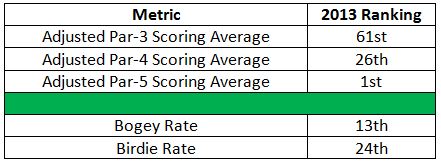
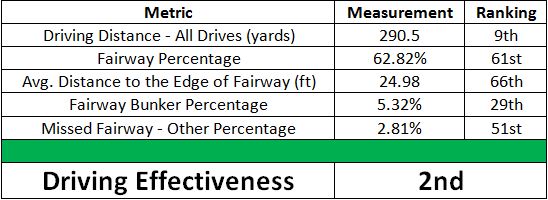

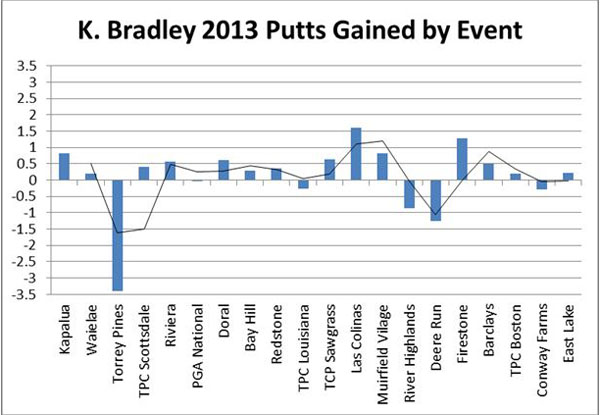















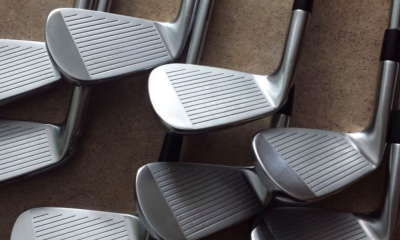













LY
Jan 1, 2014 at 12:12 pm
Rich:
What a great article! Do you do stat work with the LPGA tour and if so how do their numbers compare to the PGA tour?
LiveWire
Dec 30, 2013 at 5:28 pm
Great Data, I hope KB does better in 2014. I think he does a great job on the course. He has staying power for years to come. Hopefully he’ll win again before the Bo Sox do……
bsoudi
Dec 30, 2013 at 2:59 pm
Interesting analysis. Though it triggers 2 thoughts with me:
1) How important is the “standard deviation” of these stats? I guess I picture that as his consistency.
2) Could insight be gleaned from a comparison of all these attributes – say, could you see that on a great day driving, a player’s putting could be crap, etc.? That way players can get insights to get “all the pieces in place” more often?
Jadon
Dec 30, 2013 at 10:43 am
Wow, very interesting read. I’d like to see the same stats on Zach Johnson, a guy who is on the opposite end of the spectrum; doesn’t hit it a mile but relies on his wedges and short irons to “score” and get the job done. Goes to show you that you don’t have to be a bomber to succeed, what an odd and fun game we play.
Richie Hunt
Dec 30, 2013 at 11:11 am
Jadon, you would be shocked at how Zach got it done this year. He doesn’t hit it long, but his long approach shots (Danger Zone) is where he hit it the best from.
Mark Wells
Dec 30, 2013 at 1:57 am
Wonder why he feels he can’t work on the birdie and safe zone improvement with McClean? Solid and showing improvement otherwise. Time will tell
naflack
Dec 29, 2013 at 10:37 pm
i can see that little move off the ball that keegan does with his head being an issue on those short iron shots. im guessing chuck will want to address that…
Troy Vayanos
Dec 29, 2013 at 5:04 pm
Great post Rich,
Just shows how tough the tour is these days when a guy like Keegan can produce such impressive stats and still not come away with a victory.
Cheers
Richie Hunt
Dec 30, 2013 at 11:12 am
The bigger one is to look at Bo Van Pelt’s metrics from 2012. Outstanding ballstriker and was 11th in Putts Gained. Didn’t record 1 win. I almost found that impossible, but any given week somebody can sneak in and take it away from him.
Juan
Dec 29, 2013 at 12:11 pm
Rich, I really appreciate the great work you do with statistics!! It helps me understand the players you analyze AND a way of thinking about analyzing and improving my own game. BTW, I really like your website. THANKS again for the great work!!
Mike
Dec 29, 2013 at 11:26 am
Rich, great work. I love seeing data like this and a good thorough analysis. I look forward to reading more of your work.
Martin
Dec 29, 2013 at 9:45 am
Cool analysis, I also wonder what will happen when he switches putters.
I played with the same putter Keegan uses and gave it up because it wasn’t good enough on long putts to make up for the bit better it was on short ones. The stats seem to make the same case for Keegan.
Rob
Dec 29, 2013 at 8:16 am
Rich, interesting article, well done. I’m curious if anyone has studied “feel players” that use statistics heavily to engineer changes and what the results have been.
Rich
Dec 30, 2013 at 3:53 am
Could you really classify them as a true feel player if they looked at stats?
Rich
Dec 29, 2013 at 7:34 am
Yes I’m sure Keegan Bradley took all this into consideration when he decided to switch coaches. Actually, perhaps he’s not aware. You should drop him a line to let him know……..
Pingback: Desde el tee: semana 52/2013 | colombiaDeportes.co
Kenny Thomson
Dec 29, 2013 at 5:28 am
Another good article. How does an amateur collect such data without slowing up play? Enjoyed the book.
Kenny Thomson
Dec 29, 2013 at 5:26 am
Good article, but how does an amateur ( reasonably low handicap) capture similar data without slowing up play?
Enjoyed your book
Id
Dec 29, 2013 at 2:55 am
No glaring weakness??? What’s he going to do when he has to quit the belly putter?
Trey Hayden
Dec 29, 2013 at 5:02 am
It’s impossible to predict the future, but Bradley did win most of his college tournaments with a short putter. He switched for the same reason most guys in his generation switched: If they’re gonna let us cheat, we shall cheat.
Rob
Dec 29, 2013 at 8:05 am
You should understand the rules before making stupid comments, He doesn’t have to “quit the belly putter”
Id
Dec 29, 2013 at 10:35 am
He has to quit anchoring into the belly, therefore he has to quit that stroke. He can keep the same length putter, for sure, and use it un-anchored, therefore not calling it a non-belly putter but a putter at 43 inches or whatever – but he has to quit the belly putter. You should understand the comments before trying to sound intelligent.
Richie Hunt
Dec 30, 2013 at 11:14 am
I think I didn’t clarify what I meant by ‘glaring weakness’ anyway. What I meant is when you look at his *scoring* data (par-3’s, par-4’s, par-5’s, bogey rate and birdie rate) there was no glaring weakness there. Obviously he has a glaring weakness in his game…shots from inside 175 yards. As far as the putter goes, we will wait and see how that pans outs.
Sean
Dec 28, 2013 at 9:22 pm
Nice analysis. That right there should tell KB what he needs to work on.
Tom Stickney
Dec 28, 2013 at 7:04 pm
Great analysis Rich. Big fan of your work!
A
Dec 28, 2013 at 5:59 pm
I knew he was an idiot the moment I saw him
Homer Simpson
Dec 28, 2013 at 4:23 pm
“Facts are stubborn things, but statistics are more pliable.”
? Mark Twain
Roger
Dec 28, 2013 at 1:35 pm
Rich, thanks for another Great Article.
I see Luke Donald also moved to Chuck Cook due to his wish to
hit more par 4’s . Did a search of online videos of Chuck Cook
so thanks for the Xmas Present! I’m still young enough to Listen!
From 185 to the Pin is my problem area!
Have a great 2013 Rich.
Richie Hunt
Dec 28, 2013 at 8:46 pm
Thanks for the kind words